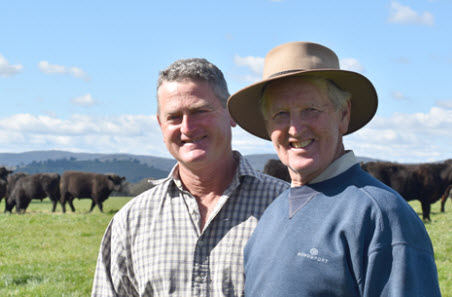Nutrition and temperament key to MSA success
20 September 2017
Eighteen years after registering as Meat Standards Australia-accredited beef producers, Ross and Colin Coyle have narrowed down the two factors they think are key contributors to the eating quality of beef – temperament and handling.

The grassfed beef producers from Wodonga won the 2017 MSA Excellence in Eating Quality Most Outstanding Beef Producer award for Victoria, presented at Lardner Park last night. (Click here for more details about the Victoria MSA Awards)
“Getting cattle to grade into the top of the MSA Index bands is 90% about what you put down their throats and the rest is keeping them quiet through handling,” Ross said.
“Breeding isn’t everything for us. Certainly the better-bred cattle will get to the standard quicker but by supplying good quality feed and treatment you can get most breeds to grade well – some just take longer than others.”
An added challenge for Ross and his father Colin is that the steers they turn off annually on 2000 hectares of mixed country in north east Victoria are destined for Greenham’s Smithton processing plant, a ferry ride across Bass Strait to North West Tasmania.
“I think it’s testament to our operation that we can load the steers onto trucks at 8am or 9am, drive them down to the Port of Melbourne and onto the ferry and they’re at Smithton for the next morning’s kill, and they grade up there with the best of the MSA beef,” Ross said.
Trading as CW Coyle & Sons, Ross and Colin registered their farm, Murray View, as an MSA supplier in 1999 but Ross said 18 years later, the standards have become “more a matter of common sense”.
“Once you get involved in adhering to the MSA protocols on the farm you start to see the benefits in grading, and that has an impact on things like the number of dark cutters, where the beef shows signs of stress in the cattle,” Ross said.
“We get very few dark cutters, we pride ourselves on that. Twelve months ago I went to Smithton to watch the MSA graders working and that helped me to understand the reasoning behind the standards.”
Ross and Colin buy in steers at 8-12 months old from the nearby Barnawartha North saleyards, one of the biggest in the State, and grow them out to over 600kg.
They select mostly British breeds. Ross said he likes Angus but will also buy in Herefords, Shorthorn and Black Baldys from a range of breeders.
“I select more on type, but we recognise good cattle and if they’re at the saleyards next time we’ll go back and buy from the same vendor,” he said.
“We used to select mainly on size, animals with as big a frame as fitted our budget, but now I take temperament into account a lot more and I’ll certainly go past a pen if there are cattle in there that are stirred up and stressed.
“I think the biggest factor in getting cattle to grade well is keeping them quiet, handling them and keeping the mobs separated with good nutrition.”
On arrival at Murray View the young cattle are drenched, ear tagged and their individual number recorded, then put out into the family’s hill country which is kept lightly stocked and grows mainly native pastures such as clovers, ryes and red grass in an annual rainfall zone of 710mm.
“We might take a round bale of lucerne hay up to them to get them coming to us but otherwise there’s not too much contact, although there are public walking tracks through there so they get quite used to seeing people, which is good.”
After six to eight months, the cattle are brought down onto the flatter, more improved country for another six to eight months and handled more often.
“They’re grazing phalaris and clover pastures and are supplemented with some hay or silage, and we’re driving around and through them so they get very quiet,” Ross said.
Ross said the benefit of MSA is the exposure to “worthwhile information”.
“MSA provides practical guidelines to use in the preparation and marketing of our product, gives us an idea of how we’re performing against benchmarks, and we have the added ability to follow feedback to see where we’ve performed well and where we can improve,” he said.
The MSA Most Outstanding Beef Producer award was open to producers that used any production system to achieve MSA eligible cattle and excluded those cattle that met grainfed beef specifications.
For more information about the MSA system, visit: www.mla.com.au/msa
To look at your own carcase feedback and use the MSA Index calculator, visit: www.mymsa.com.au


